-
DRV2603 Haptic Drive With Auto-Resonance Detection for Linear Resonance Actuators (LRA)
- 1 Features
- 2 Applications
- 3 Description
- 4 Revision History
- 5 Pin Configuration and Functions
- 6 Specifications
- 7 Parameter Measurement Information
-
8 Detailed Description
- 8.1 Overview
- 8.2 Functional Block Diagram
- 8.3
Feature Description
- 8.3.1 Supply Voltage Rejection for Constant Vibration Strength
- 8.3.2 Low-Voltage Control Logic for Constant Vibration Strength
- 8.3.3 Thermal Protection
- 8.3.4 Overcurrent Protection
- 8.3.5 Linear Resonance Actuators (LRA)
- 8.3.6 Auto Resonance Engine for LRA
- 8.3.7 Eccentric Rotating Mass Motors (ERM)
- 8.3.8 Edge Rate Control
- 8.4 Device Functional Modes
- 9 Application and Implementation
- 10Power Supply Recommendations
- 11Layout
- 12Device and Documentation Support
- 13Mechanical, Packaging, and Orderable Information
- IMPORTANT NOTICE
パッケージ・オプション
メカニカル・データ(パッケージ|ピン)
- RUN|10
サーマルパッド・メカニカル・データ
- RUN|10
発注情報
DRV2603 Haptic Drive With Auto-Resonance Detection for Linear Resonance Actuators (LRA)
1 Features
- Flexible Haptic/Vibra Driver
- LRA (Linear Resonance Actuator)
- ERM (Eccentric Rotating Mass)
- Auto Resonance Tracking for LRA
- No Frequency Calibration Required
- Automatic Drive Commutation
- Automatic Braking Algorithm
- Wide Input PWM Frequency Range
- Constant Vibration Strength Over Supply
- Automatic Input Level Translation
- 0% to 100% Duty Cycle Control Range
- Fast Start Up Time
- Differential Drive from Single-Ended Input
- Wide Supply Voltage Range of 2.5 V to 5.2 V
- Immersion TouchSense® 3000 Compatible
- 1.8-V Compatible, 5-V Tolerant Digital Pins
- Available in a 2 mm × 2 mm × 0.75 mm Leadless QFN Package (RUN)
2 Applications
- Mobile Phones and Tablets
- Watches and Wearable Technology
- Remote Controls, Mice, and Peripheral Devices
- Electronic Point of Sale (ePOS)
- Vibration Alerts and Notifications
- Touch-Enabled Devices
- Industrial Human-Machine Interfaces
3 Description
The DRV2603 is a haptic driver designed specifically to solve common obstacles in driving both Linear Resonance Actuator (LRA) and Eccentric Rotating Mass (ERM) haptic elements. The DRV2603 is designed for low latency, high efficiency, and more drive strength for actuators commonly used for tactile feedback in the portable market.
LRA actuators typically have a narrow frequency band over which they have an adequate haptic response. This frequency window is typically ±2.5 Hz wide or less, so driving an LRA actuator presents a challenge. The DRV2603 solves this problem by employing auto resonance tracking, which automatically detects and tracks the LRA resonant frequency in real time. This means that any input PWM frequency within the input range (10 kHz to 250 kHz) will automatically produce the correct resonant output frequency. As an additional benefit, the DRV2603 implements an automatic braking algorithm to prevent LRA ringing at the end of waveforms, leaving the user with a crisp haptic sensation.
For both ERM and LRA actuators, the automatic input level translation solves issues with low voltage PWM sources without adding additional external components, so if the digital I/O levels vary, the output voltage does not change. The DRV2603 also has supply correction that ensures no supply regulation is required for constant vibration strength, allowing an efficient, direct-battery connection.
Device Information(1)
| PART NUMBER | PACKAGE | BODY SIZE (NOM) |
|---|---|---|
| DRV2603 | WQFN (10) | 2.00 mm × 2.00 mm |
- For all available packages, see the orderable addendum at the end of the datasheet.
DRV2603 Block Diagram
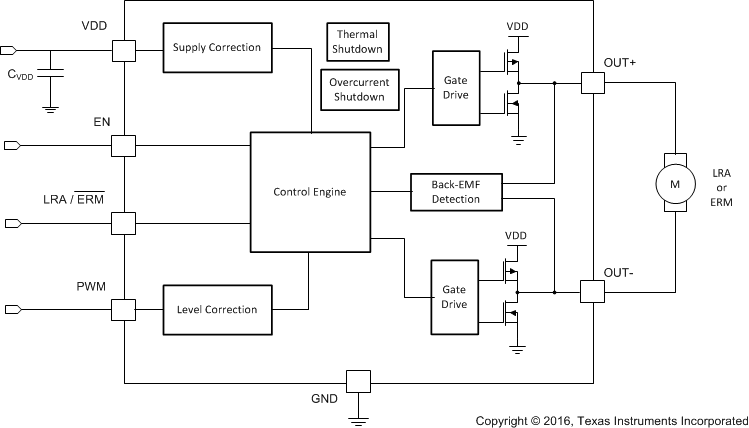
4 Revision History
Changes from B Revision (September 2015) to C Revision
- Auto Resonance Engine for LRA, changed text From: "tracking range for LRA devices is 140 Hz to 140 Hz" To: "tracking range for LRA devices is 140 Hz to 220 Hz."Go
Changes from A Revision (January 2014) to B Revision
- Added Pin Configuration and Functions section, ESD Ratings table, Feature Description section, Device Functional Modes, Application and Implementation section, Power Supply Recommendations section, Layout section, Device and Documentation Support section, and Mechanical, Packaging, and Orderable Information section Go
Changes from * Revision (June 2012) to A Revision
- Changed from 1 page data sheet to full data sheet in product folderGo
5 Pin Configuration and Functions

Pin Functions
| PIN | I/O/P(1) | DESCRIPTION | |
|---|---|---|---|
| NAME | NO. | ||
| EN | 1 | I | Device enable |
| GND | 5, 8, 10 | P | Supply ground |
| LRA/ERM | 3 | I | Mode selection. ERM = Low, LRA = High |
| NC | 4 | I | No Connection |
| OUT+ | 9 | O | Positive haptic driver differential output |
| OUT– | 6 | O | Negative haptic driver differential output |
| PWM | 2 | I | Input signal |
| VDD | 7 | P | Supply Input (2.5 V to 5.5 V) |
6 Specifications
6.1 Absolute Maximum Ratings(1)
over operating free-air temperature range, TA = 25°C (unless otherwise noted)| MIN | MAX | UNIT | |||
|---|---|---|---|---|---|
| Supply voltage | VDD | –0.3 | 6 | V | |
| VI | Input voltage | EN, PWM, LRA/ERM | –0.3 | VDD + 0.3 | V |
| TA | Operating free-air temperature range | –40 | 85 | °C | |
| TJ | Operating junction temperature range | –40 | 150 | °C | |
| Tstg | Storage temperature range | –65 | 150 | °C | |
6.2 ESD Ratings
| VALUE | UNIT | |||
|---|---|---|---|---|
| V(ESD) | Electrostatic discharge | Human body model (HBM), per ANSI/ESDA/JEDEC JS-001(1) | ±2000 | V |
| Charged-device model (CDM), per JEDEC specification JESD22-C101(2) | ±500 | |||
6.3 Recommended Operating Conditions
| MIN | TYP | MAX | UNIT | |||
|---|---|---|---|---|---|---|
| VDD | Supply voltage | VDD | 2.5 | 5.2 | V | |
| fPWM | PWM Input frequency | 10 | 250 | kHz | ||
| RL | Load Impedance | VDD = 5.2 V | 8 | Ω | ||
| F0 | Supported LRA frequency | Auto resonance tracking range for LRA | 140 | 220 | Hz | |
| VIL | Digital input low voltage | EN, PWM, LRA/ERM | 0.6 | V | ||
| VIH | Digital input high voltage | EN, PWM, LRA/ERM | 1.2 | V | ||
| TA | Operating free-air temperature range | -40 | 85 | °C | ||
6.4 Thermal Information
| THERMAL METRIC(1) | DRV2603 | UNIT | |
|---|---|---|---|
| RUN (WQFN) | |||
| 10 PINS | |||
| RθJA | Junction-to-ambient thermal resistance | 153.7 | °C/W |
| RθJC(top) | Junction-to-case (top) thermal resistance | 86 | °C/W |
| RθJB | Junction-to-board thermal resistance | 70.4 | °C/W |
| ψJT | Junction-to-top characterization parameter | 1.3 | °C/W |
| ψJB | Junction-to-board characterization parameter | 70.4 | °C/W |
6.5 Electrical Characteristics
TA = 25°C, VDD = 3.6 V (unless otherwise noted)| PARAMETER | TEST CONDITIONS | MIN | TYP | MAX | UNIT | ||
|---|---|---|---|---|---|---|---|
| |IIL| | Digital input low current | EN, PWM, LRA/ERM | VDD = 5.0 V, VIN = 0 V | 1 | µA | ||
| |IIH| | Digital input high current | EN | VDD = 5.0 V, VIN = VDD | 6 | µA | ||
| PWM, LRA/ERM | VDD = 5.0 V, VIN = VDD | 3 | µA | ||||
| ISD | Shut down current | VEN = 0 V | 0.3 | 3 | µA | ||
| IDDQ | Quiescent current | VEN = VDD, ERM Mode, 50% duty cycle input, No load | 1.7 | 2.5 | mA | ||
| ROUT | Output impedance in shutdown | OUT+ to GND, OUT– to GND | 15 | kΩ | |||
| tSU | Start-up time | Time from EN high to output signal | 1.3 | ms | |||
| fSW | PWM output frequency | 19.5 | 20.3 | 21.5 | kHz | ||
| IBAT,AVG | Average battery current during operation | Duty Cycle = 100%, LRA Mode, Load = 25 Ω LRA | 55 | mA | |||
| Duty Cycle = 80%, ERM Mode, RL = 17 Ω, 2V rated ERM | 59 | ||||||
| RDS-HS | Drain to source resistance, high-side | 1.05 | Ω | ||||
| RDS-LS | Drain to source resistance, low-side | 0.85 | Ω | ||||
| VOUT | Differential output voltage | Duty Cycle = 100%, LRA Mode, Load = 25 Ω LRA | 2.2 | VRMS | |||
| Duty Cycle = 100%, ERM Mode, RL = 20 Ω ERM | 3.3 | V | |||||
| Thermal threshold | 145 | °C | |||||
| Thermal Hysteresis | 18 | °C | |||||
6.6 Typical Characteristics
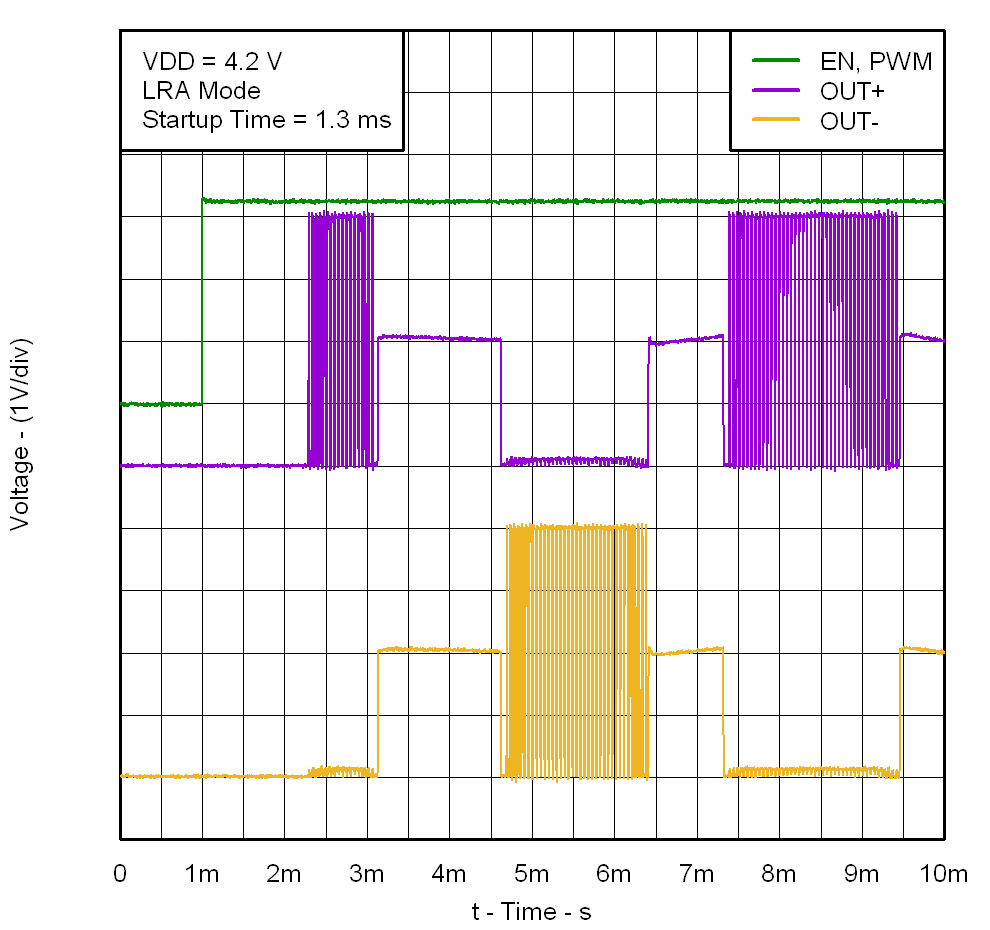 Figure 1. Startup Waveform
Figure 1. Startup Waveform
 Figure 3. LRA Click
Figure 3. LRA Click
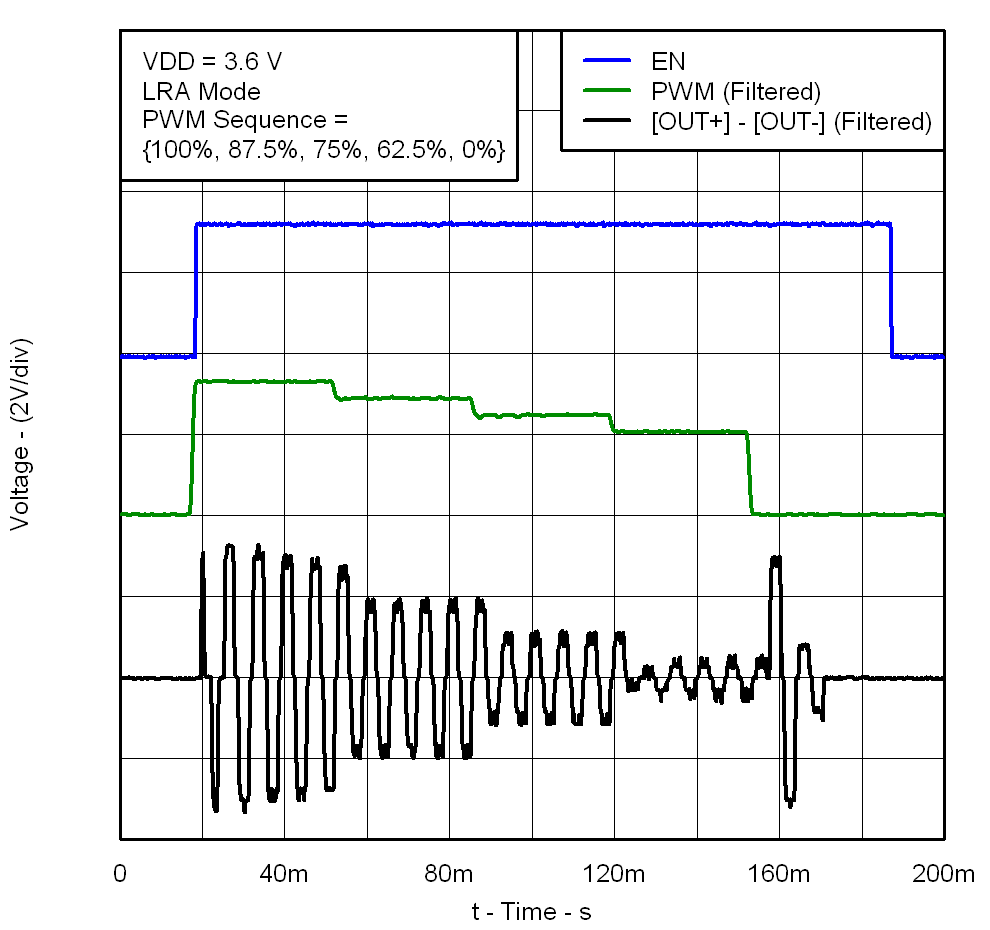 Figure 5. LRA PWM Modulation
Figure 5. LRA PWM Modulation
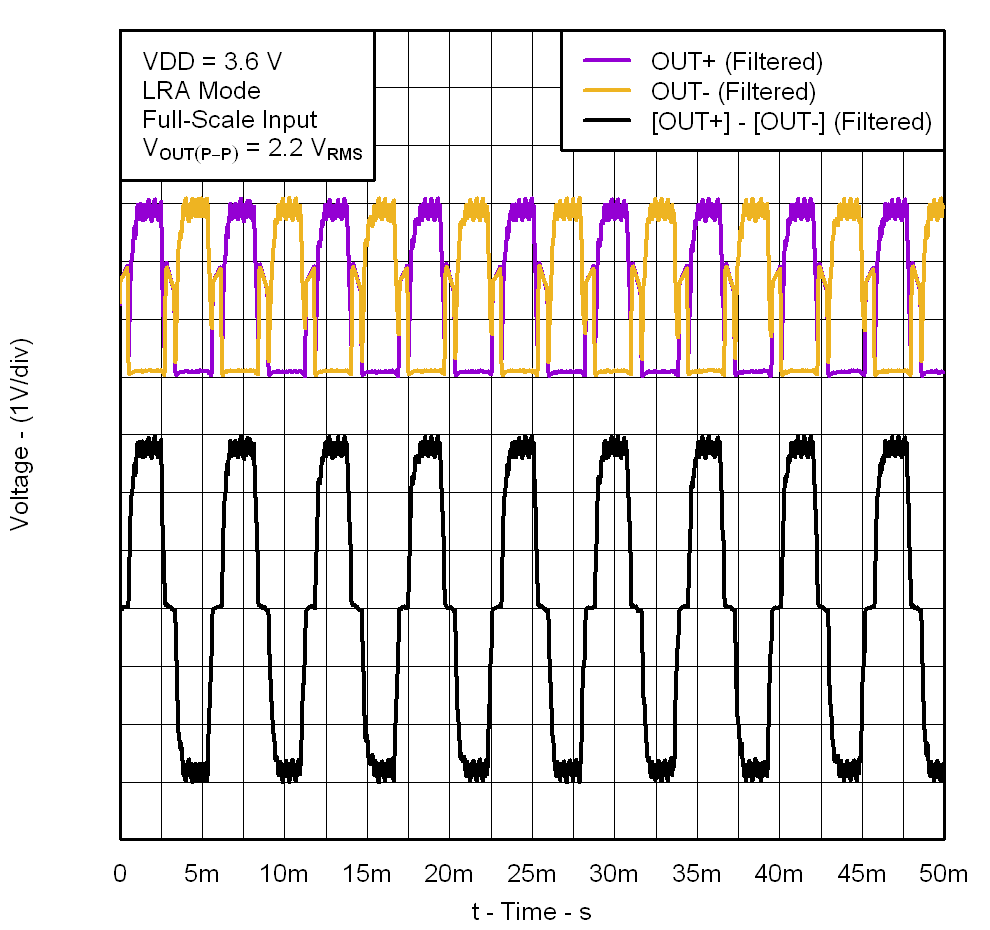 Figure 2. LRA Full-Scale Drive
Figure 2. LRA Full-Scale Drive
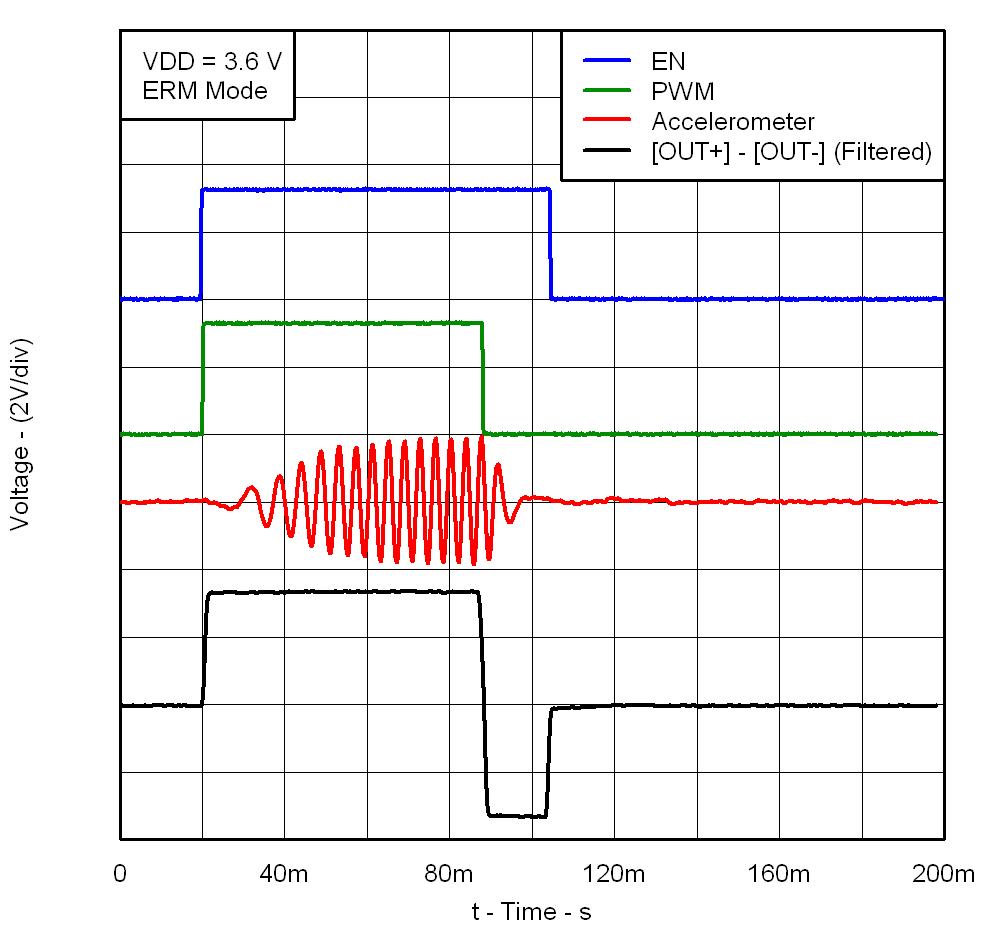 Figure 4. ERM Click
Figure 4. ERM Click
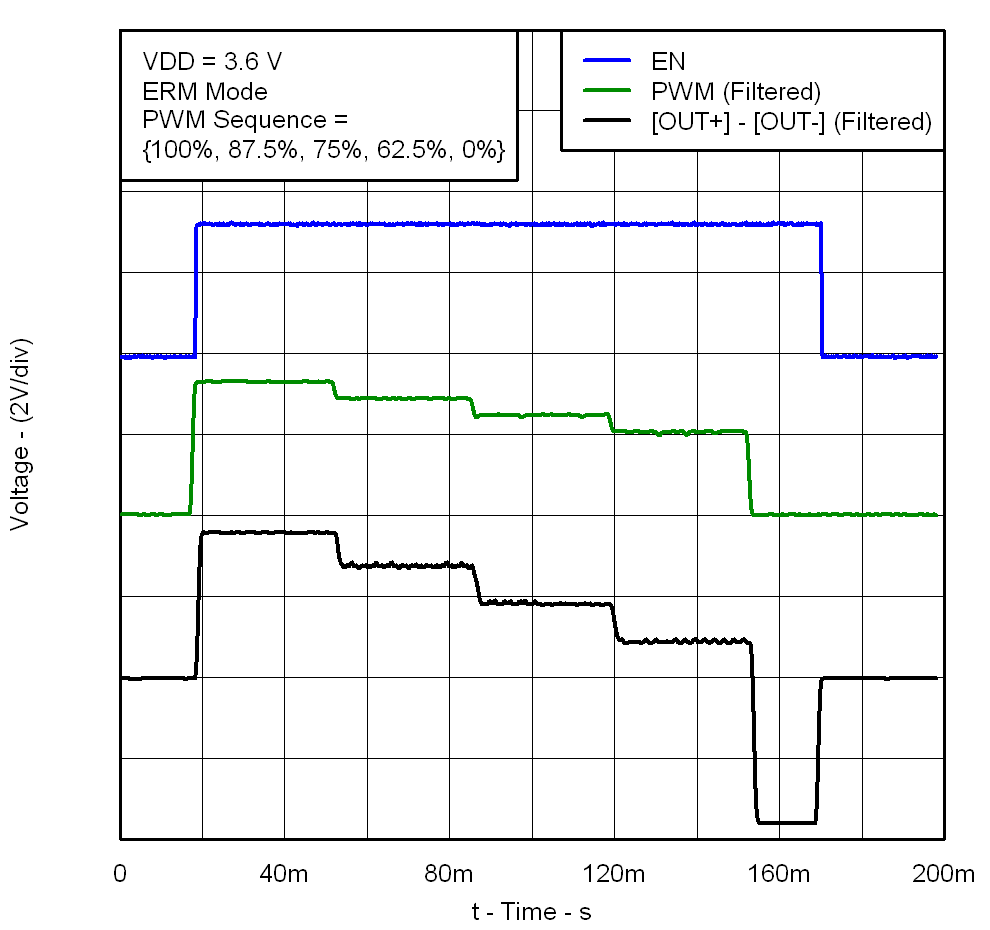 Figure 6. ERM PWM Modulation
Figure 6. ERM PWM Modulation